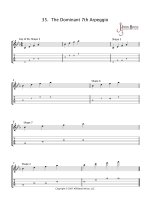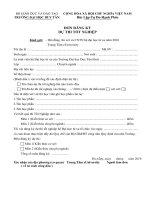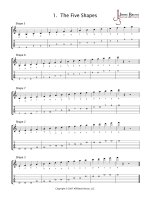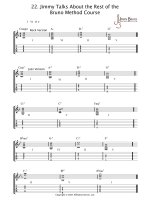The art of community 1ed tủ tài liệu bách khoa
Bạn đang xem bản rút gọn của tài liệu. Xem và tải ngay bản đầy đủ của tài liệu tại đây (2.17 MB, 394 trang )
Praise for The Art of Community
“The Internet provides the potential to separate us into a cacophony of discordant voices or to congregate us as purpose-driven communities. Jono Bacon,
in his insightful The Art of Community, teaches the latter path, detailing the
principles of successful community-building in a way that will appeal to both
neophyte and expert alike. Given the increasingly critical role of community
managers in the technology industry and beyond, The Art of Community should
find a place on any businessperson’s bookshelf, not to mention that of the PTA
president, book club organizer, or union activist. Yes, it’s that good.”
—MATT ASAY, ALFRESCO AND C|NET
“Jono Bacon truly understands communities, and, more importantly, how to
build communities that thrive. This is the definitive guidebook to building successful communities—definitive because it is based on Jono’s extensive experience as community manager for Ubuntu, a product that inspires an Apple-esque
devotion in very large part because of its vast and dedicated community. For
developers and entrepreneurs who want to learn how to tap into the power of
community, as Ubuntu has done so masterfully, this book is a must-read.”
—IAN MURDOCK, FOUNDER OF DEBIAN AND VICE PRESIDENT OF EMERGING
PLATFORMS AT SUN
“One thing that’s impressed me about Jono Bacon—something one can notice
back when he and others were building a community around their pioneering
Linux podcast—is that he simply gets the concept of community. It comes out
in most everything he says and most every decision he makes. This is the kind
of a person you want writing a book on the topic. Open source community
building cannot be boiled down to a formula. It’s a constant effort, a soft science, an art, and Bacon is an ideal art teacher.”
—DAN GOLDSTEIN, PROFESSOR OF MARKETING, LONDON BUSINESS SCHOOL,
AND PRINCIPAL RESEARCH SCIENTIST, YAHOO! RESEARCH
“The success of the open source software movement demonstrates that no
obstacle is insurmountable when people come together around a shared
vision. In The Art of Community, Ubuntu Community Manager Jono Bacon
gives readers a profound glimpse into his hands-on experience as the orchestrator of one of the movement’s most powerful communities. His book offers
valuable lessons on effective leadership and community building. Its compelling combination of useful theory, real-world best practices, and instructive
personal anecdotes make it a richly comprehensive guide for both aspiring
and experienced community leaders.”
—RYAN PAUL, ARS TECHNICA
“Communities are very complex ecosystems of human beings. Cultivating,
growing, shaping, and guiding the community to make it productive is definitely as much (or even more) art as science. In The Art of Community, Bacon
does an excellent job of explaining in detail the considerations for managing
and cultivating a healthy open source community. He provides a blueprint for
developing and maintaining an open source community in a programmatic
way, and his attention to detail and understanding of the dynamics of communities make this book an invaluable resource for anyone looking to build
and maintain a community. Drawing from his own extensive experience,
Bacon does a great job of explaining how to help foster a community, and
provides great advice, ranging from choosing infrastructure, measuring
growth, and even hiring a community manager. All in all a must-read for any
community manager.”
—MARK R. HINKLE, VICE PRESIDENT OF COMMUNITY, ZENOSS, INC.
“Jono Bacon has long been an insightful voice for the open source community.
Now his artful stories distilling the ethos of organizing people and activities on
the Net, at conferences, and in our daily routines provide a framework for successful, community-building strategies.”
—PETE KRONOWITT, LINUX AND OPEN SOURCE STRATEGIST, INTEL
“In The Art of Community, Jono Bacon once again shows that his nom de guerre is
apropos. He breaks down the soft science of community management in a way
few others could. With his trademark British humor, he deftly explores the
intricacies and subtleties of his trade. The result is both informative and entertaining, and is a must-read for those looking to better understand the soft science that is community management.”
—JEREMY GARCIA, FOUNDER OF LINUXQUESTIONS.ORG
“To a soundtrack of heavy metal, free-software geekstar Jono Bacon recounts
the story of how he learned to gently yet productively manhandle groups of
unruly Internet folks gathered around a common topic or cause. His process
and methods are set out in his book, The Art of Community, where Jono’s
non-ego-driven account of community building will aid all manner of
bosses, since almost every subject matter these days has a community with
hundreds, thousands, tens of thousands, and even (as in the case of World of
Warcraft) millions of people clamoring around it. (Even David Hasselhoff!)
Be forewarned, capitalist! There is no chapter called ‘How to Turn Communities into Dollars,’ but following Jono’s suggestions may yield you what
every leader (even a capitalist) wants: a loyal and passionate community willing to collaborate to achieve a common goal.”
—IRINA SLUTSKY, GEEKENTERTAINMENT.TV
“If you listen to open source fans, you might get the idea that the community is
elves who come out of the woodwork to fix your broken software while you
sleep. In The Art of Community, Jono Bacon explains how reality is a little more
complicated, and what the community needs in return. This book will help you
get started with the diverse skills required to keep a collaborative community
on track, including copywriting, social software selection, conflict resolution,
and measuring if it’s all working.”
—DON MARTI, CONFERENCE CHAIR, OPENSOURCE WORLD, AND ORGANIZER,
WINDOWS REFUND DAY, BURN ALL GIFS DAY, FREE DMITRY, AND
FREEDOMHEC
“Who would have known, when I first met a scruffy student from Wolverhampton Uni at a LUG meeting all those years ago, that he would end up
being the name on the Internet synonymous with the word ‘community.’ The
fact that the Internet’s Jono Bacon is now one of the foremost authorities on
building and nurturing a community shows that in a volunteer project no one
cares about your questionable dress sense, dodgy taste in music, or strange
choices in facial hair—all that matters are your contributions, and your ability
to get on with, and inspire, others.
“In this book, Jono draws upon a wealth of experience from projects small to
big (and when you consider the worldwide phenomenon that was LugRadio,
and the worldwide phenomenon that is Ubuntu, you’re talking pretty big) to
lay out a blueprint for creating and sustaining communities, as well as using
real-world examples from prime ministers to celebrity chefs to ground the
topics in a wider context. There is a nice balance in that many of the examples
are based on success stories, but Jono is brave enough to also illustrate his
points with some of his (relatively few) mistakes.
“This book will be useful for anyone looking to build a volunteer community
around any kind of project or cause, whether it involves software, open
source, raccoons, or none of the above.”
—PAUL COOPER, MOBLIN UI & APPS ENGINEERING MANAGER, INTEL
“As a rock-solid book, The Art of Community is not only about communities, but
also management, organization, and even marketing—it is the bible for community leadership. This book should have been out a long time ago, and reading through the chapters made me reflect on almost every important situation I
had to face with teams, from conflicts all the way to handling buzz. It would
have helped solve some of the issues I was stuck in much faster than I did
(although all the issues solved in the end were exactly how Jono described it). I
am eager to apply more of this wisdom on the current projects I am involved
in.”
—SEIF LOTFY, GNOME FOUNDATION, ZEITGEIST COFOUNDER AND TEAM LEADER
“Few people, in my experience, understand how to create, build, and support
community better than Jono Bacon. With The Art of Community, Jono’s taken
his experience, his intelligence, as well as his great humor, and has effectively
distilled it into an indispensable book for anyone who wants to start a community (whether around software or any other shared interest or endeavor,
really) or participate in one in a positive and productive way. Jono understands that communication and authenticity are at the core of effective participation, and goes beyond the theoretical to provide practical guidance on
things like governance, process, conflict resolution, and avoiding burnout that
is right on the mark. The Art of Community is an excellent book!”
—DAVID SCHLESINGER, DIRECTOR, OPEN SOURCE TECHNOLOGIES,
ACCESS CO., LTD.; GNOME FOUNDATION ADVISORY BOARD MEMBER
“Jono Bacon, in The Art of Community, takes you on a personal journey to the
heart of what it takes to have and become part of a productive and well-oiled
community.”
—AMBER GRANER, UBUNTU COMMUNITY MEMBER
“Jono Bacon’s The Art of Community is a wonderful meditation on building
communities using modern infrastructure tools and practices gleaned from the
Free and Open Source Software movement. Jono’s examples, taken from his
work on Ubuntu, give a good picture of a working community and how it
functions. The fact that the book is backed by a conference (http://www.
communityleadershipsummit.com/wiki/index.php/Session_Notes) and an online
community ( means this fine effort will potentially continue to grow into the watering hole for community gardeners, leaders, and managers.”
—DANESE COOPER, OPEN SOURCE DIVA AND OSI DIRECTOR
The Art of Community
The Art of Community
Jono Bacon
Beijing • Cambridge • Farnham • Köln • Sebastopol • Taipei • Tokyo
The Art of Community
by Jono Bacon
Copyright © 2009 Jono Bacon. All rights reserved.
Printed in the United States of America.
Published by O’Reilly Media, Inc., 1005 Gravenstein Highway North, Sebastopol, CA 95472.
O’Reilly books may be purchased for educational, business, or sales promotional use. Online editions are also
available for most titles (). For more information, contact our corporate/
institutional sales department: (800) 998-9938 or
Editors: Andy Oram and Simon St.Laurent
Production Editor: Sumita Mukherji
Copyeditor: Genevieve d’Entremont
Proofreader: Sada Preisch
Indexer: John Bickelhaupt
Cover Designer: Mark Paglietti
Interior Designer: David Futato
Illustrator: Robert Romano
Printing History:
August 2009:
First Edition.
Nutshell Handbook, the Nutshell Handbook logo, and the O’Reilly logo are registered trademarks of O’Reilly
Media, Inc. The Art of Community, the image on the cover, and related trade dress are trademarks of O’Reilly
Media, Inc.
Many of the designations used by manufacturers and sellers to distinguish their products are claimed as
trademarks. Where those designations appear in this book, and O’Reilly Media, Inc., was aware of a trademark
claim, the designations have been printed in caps or initial caps.
While every precaution has been taken in the preparation of this book, the publisher and author assume no
responsibility for errors or omissions, or for damages resulting from the use of the information contained
herein.
Printed on Rolland Enviro100 Book, which contains 100% post-consumer fibers and is manufactured in
Canada by Cascades using biogas energy.
ISBN: 978-0-596-15671-8
[V]
1248982100
For my loving wife, Erica, and all the ways
she makes me smile
CONTENTS
FOREWORD
xvii
PREFACE
xix
1
THE ART OF COMMUNITY
Collaboration-Driven Ethos
The Essence of Community
The Basis of Communication
Unwrapping Opportunity
A Community Manager: Becoming the Community
Moving Forward
1
2
3
8
10
13
19
2
PLANNING YOUR COMMUNITY
Planning for Success
Teams: The Building Blocks of Belonging
Designing Your Community
Filling Out the Plan
Pulling Together the Threads
Documenting Your Strategy
Wrapping Up
21
23
31
43
52
55
61
63
3
COMMUNICATING CLEARLY
He Said, She Said
Building Your Communication Channels
Leading by Example
Summary
65
66
67
75
89
4
PROCESSES: SIMPLE IS SUSTAINABLE
Eyes on the Prize
Building Great Processes
Assessing Needs
Getting Buy-In for Your Processes
Process Reassessment
Moving On
91
92
94
101
112
115
117
5
SUPPORTING WORKFLOW WITH TOOLS
Understanding Your Workflow
Building Great Infrastructure
Avoiding Resource Fetishism
Technical Considerations
Building and Maintaining Transparency
Regular Workflow Assessment
119
120
129
133
133
137
141
xiii
Moving On
143
6
BUILDING BUZZ
Mindshare
The Building Blocks of Buzz
Setting Up Your Base
The Buzz Cycle
Buzz Targets
Building Alliances
Summary
145
146
148
154
163
170
175
186
7
MEASURING COMMUNITY
Community Self-Reflection
The Foundations of Feedback
Hooks ’n’ Data
Anonymity and Privacy
Moving On
187
188
189
190
206
209
8
GOVERNANCE
Accountability
Governance Does Not Suck
Governance and Community
The Case for Governance
Learning from the Leaders
Setting Up a Community Council
Ubuntu Governance Example
Expanding Governance
Summary
211
213
213
214
215
221
226
245
260
265
9
HANDLING CONFLICT
The Nature of the Beast
The Calm Before the Storm
The Conflict Resolution Process
Dealing with Burnout
Summary
267
268
270
280
294
300
10
CREATING AND RUNNING EVENTS
Building Family Values
Events
Getting Organized
Organizing Physical Events
Getting Sponsorship
Organizing Online Events
Summary
301
302
303
305
308
324
329
339
11
HIRING A COMMUNITY MANAGER
Why Community Building Has Become a Big Business
The Role of a Community Manager in the Corporation
Managing Your Community Manager
Summary
341
343
344
351
356
xiv
CONTENTS
End of Part One
357
INDEX
359
CONTENTS
xv
FOREWORD
ANTS TO ANTEATERS , bees to beekeepers, community is a fundamental part of our life
on the planet. We thrive when we are immersed in it, suffer when deprived of it, and wherever
humans go we create it. We define ourselves by our communities: tribe, family, work, clubs,
schools, churches and temples, these are who we are. We are born into community, and if
we’re lucky we’ll end our days surrounded by it.
F ROM
It’s no surprise that as soon as humans began to go online, communities formed, but as easy
and natural as group formation is for us in real life, we can find it frustrating online. Many of
the cues that grease the wheels of human interaction in person are missing online. Gone is the
grin that can soften a criticism, the pat on the back that can heal a rift. How can you “hug it
out” when your antagonist is a continent away and you know no more about him than his
handle and a few lines of signature? Online groups can breed the most vicious of rivalries. The
Hatfields and McCoys have nothing on alt.tv.doctorwho.
Communities are tough enough to maintain when you’re all in the same room; how much
harder is it to build, maintain, and nurture a community online? That’s why this book is such
a boon to those who run communities and the rest of us who participate in them. Jono Bacon
has firsthand experience with managing a group of the most bloody-minded and independent
people on the planet: open source programmers. The information in this book has been forged
in the white-hot crucible of free software. You don’t get tougher than that.
xvii
My experience with online forums began 25 years ago when I started a bulletin board for
Macintosh users called MacQueue. It’s not easy to start a flame war with dual 14.4 kbps
modems and 20 MB of storage, but the MacQueuers managed. A few years later I joined The
Well, a legendary online community based in Sausalito, California, and imbued with the peace
and love ethos of the San Francisco hippies. That didn’t last long. The Well went through an
arc I came to know intimately, one that most online communities seem to follow.
When any affinity group forms online it’s a joyous occasion. The founders and early members
are wreathed in the cooperative enthusiasm that accompanies most new beginnings.
Conversations are civil, helpful, and kind. Posts twinkle with good spirits and bonhomie. All’s
right with the Web. Then the rot begins to set in. Tempers flair, resentments build, rivalries
form. It’s a lot like marriage.
Unlike most marriages, however, online members have looser ties to the group and a reduced
stake in its success. When trolls become annoying, the flame wars too fiery, members move
on, and pretty soon that happy online forum turns into a ghost town, or worse.
But it doesn’t have to be that way. With his usual wit and good humor, Jono has written a
guide with everything you need to keep your online groups healthy and productive. With
proper planning, a modicum of guidance, and the occasional banishment, your community
can avoid that seemingly inevitable descent into fear and loathing. We need good community
managers because we need healthy communities online. I’ve started my share of communities
online, and killed a few with neglect, too. I’m so grateful to Jono for giving me the tools to do
it right from now on. I know we all are.
—Leo Laporte
Broadcaster and Founder of the TWiT Network
Petaluma, California
June 30, 2009
xviii
FOREWORD
PREFACE
C OMMUNITY IS A FUNNY OL ’ WORD . In recent years our humble nine-letter friend has gone on
to mean many things to many people. No longer merely the domain of charity groups and
overtly friendly neighbors, community has gone on to be the talk of technologists, businesspeople, politicians, students, welfare groups, and just about anyone who has connected to the
Internet. Throughout this explosive community love-fest, a minor detail has been omitted in
all the excitement: how on earth do we built an inspiring, engaging, and enjoyable community
in our own walk of life?
Toward the end of Summer 2008 I received a phone call from Andy Oram, a well-respected
author and editor at O’Reilly. Although at the start of the call Andy was soliciting advice for
building community in the educational world, the call ended by sowing the seeds for The Art
of Community.
Andy’s interest in putting together this book was intriguing, but it could not have come at a
more complicated time. My days were hectic as the Ubuntu community manager, leading my
team to grow, refine, and optimize the global Ubuntu community; I was in the midst of
recording a solo metal album as part of a new Creative Commons project called Severed Fifth;
I was coorganizing LugRadio Live 2008, recording and producing LugRadio shows every two
weeks; and I was making plans to relocate to California. I had written three books before and
I was intimately aware of just how incredibly time-consuming they are. Writing a book is like
having a baby: it requires care and attention, and typically results in late nights, lack of sleep,
xix
and heartburn. Consequently, my best friend (who is also an author) and I had struck a nomore-books pact.
Despite all of this, I was intrigued. Community and the skills involved in motivating, building,
and inspiring it were rampantly undocumented, and much of my own skills had been
developed through trial and error, exposing myself to different communities and observing
how they worked. I was fortunate enough to have cut my teeth in community in some
compelling environments, and I had always wanted to write a book on the topic.
Fortunately none of these aforementioned challenges made any difference when I talked it
through with my best friend, Stuart. He and I have been discussing, debating, and at times
arguing about community since 1999, and he knows my views, perspectives, drive, and
ambitions about community better than anyone. What’s more, he had been wittering on about
me writing something down about community, despite our no-more-books pact. Ten minutes
with that ginger ball of fury and my mind was made up: it was time to buy some anti-heartburn
pills and get some coffee in....
Documenting the Undocumented
Part of my initial hesitation in writing a book on community was that I knew it was going to
be a tough one to write. In my talks at conferences I often referred to my role as “herding cats.”
Much of the art of community is subtle, undocumented, and unwritten, and much of my own
approach was largely the product of feeling my way around in the dark and learning from what
I found. I knew that to write this book I would need to think carefully about not only how to
articulate these topics, but also how to handle the more complex challenge of structuring this
stream of consciousness into a consistent read that, y’know, actually makes sense.
What you hold here is the result of that challenge, and I am proud of the results. This book
brings together many of the primary elements involved in building a productive, collaborative
community. To do this I distilled my own experiences and insight along with wisdom from
others and illustrated these topics using a wealth of examples, stories, and anecdotes. This book
begins by taking a high-level view of how communities work at a social science level, and then
we delve straight into topics such as strategic planning, communicating well, building effective
and non-bureaucratic processes and infrastructure, creating buzz and excitement, handling
conflict and burnout, measuring community, creating and managing governance, organizing
events, and even how to hire a community manager.
While this first edition provides a solid map for the road ahead, I am a firm believer that the
road map will continue to expand and take on color and texture through further editions.
Community leadership is still very much a young science, and this book is the beginning of
what I hope to see as a series of further editions that expand and refine this focus. Where
much of this insight will continue to grow is on the book’s website at http://www
.artofcommunityonline.org and at the annual community leadership event that I organize, the
Community Leadership Summit. I would like to invite all of you good people to first enjoy The
xx
PREFACE
Art of Community and to then provide your own feedback, stories, and experiences to guide
future editions.
Who Is This Book For?
This book has been written to be open and applicable to a wide range of communities. While
O’Reilly is traditionally a computer book publisher, The Art of Community is not specifically
focused on computing communities, and the vast majority of its content is useful for anything
from political groups to digital rights to knitting and beyond.
Within this wide range of possible communities, this book will be useful for a range of readers:
Professional community managers
If you work in the area of community management professionally
Volunteers and community leaders
If you want to build a strong and vibrant community for your volunteer project
Commercial organizations
If you want to work with, interact with, or build a community around your product or
service
Open source developers
If you want to build a successful project, manage contributors, and build buzz
Marketeers
If you want to learn about viral marketing and building a following around a product or
service
Activists
If you want to get people excited about your cause
Every chapter in this book is applicable to each of these roles. While technology communities
provide many examples throughout the book, the purpose of these examples requires little
technical knowledge.
The Road Ahead
Throughout this book we are going to delve into the wide range of topics that face those of us
who want to build and inspire great communities. Page after page we are going to weave an
intricate web of the concepts, skills, and approaches involved in energizing a vibrant
community and helping the members of that community to energize themselves.
This book is broken into 11 chapters, with each building on what went before. Let’s take a
quick glance at the road ahead:
PREFACE
xxi
Chapter 1, The Art of Community
We begin the book with a bird’s-eye view of how communities function at a social science
level. We cover the underlying nuts and bolts of how people form communities, what
keeps them involved, and the basis and opportunities behind these interactions.
Chapter 2, Planning Your Community
Next we carve out and document a blueprint and strategy for your community and its
future growth. Part of this strategy includes the target objectives and goals and how the
community can be structured to achieve them.
Chapter 3, Communicating Clearly
At the heart of community is communication, and great communicators can have a
tremendously positive impact. Here we lay down the communications backbone and the
best practices associated with using it.
Chapter 4, Processes: Simple Is Sustainable
We then move on to focus on putting the facilities in place for your community to do great
things. In this chapter we build simple, effective, and nonbureaucratic processes that
enable your community to conduct tasks, work together, and share their successes.
Chapter 5, Supporting Workflow with Tools
We continue our discussion of community facilities to build workflows that are driven by
accessible, sensible, and rock-solid tools that enable your contributors to do great work
quickly and easily.
Chapter 6, Building Buzz
With a solid foundation in place, we move on to build excitement and buzz around your
community and encourage and enthuse every man and his dog to get involved and
participate.
Chapter 7, Measuring Community
Although many consider community hand-wavey and unmeasurable, this chapter
confronts the myth and guides you in tracking, monitoring, and otherwise measuring the
work going on the community so it can be optimized and simplified.
Chapter 8, Governance
Our next stop is the wide-ranging and seemingly complex topic of governance. We explore
what options are available for a low-friction, capable, and representative governance
strategy for your community.
Chapter 9, Handling Conflict
One of the most sensitive topics in community leadership is handling conflict. In this
chapter we explore how to identify, handle, and prevent irksome conflict; handle divisive
personalities; and unblock problems.
Chapter 10, Creating and Running Events
Events offer an excellent opportunity for your community to bond, be productive, and
have fun, and this is where we cast our beady eye in our penultimate chapter.
xxii
PREFACE
Chapter 11, Hiring a Community Manager
Finally, we close The Art of Community with some advice and guidance for organizations
who want to hire a community manager to conduct and implement the wide range of
topics that we have discussed throughout the book.
Each of these broad topics is a piece in the jigsaw puzzle, a note in the song, and a letter in the
book. Step by step we will discuss these topics using a liberal supply of stories, anecdotes, and
examples to illuminate the path ahead. As we continue throughout the book, more and more
of the road will become clear, and you will begin to develop your own approaches, patterns,
and methods of engaging your own community.
If You Like (or Don’t Like) This Book
If you like—or don’t like—this book, by all means, please let people know. Amazon reviews
are one popular way to share your happiness (or lack of happiness), or you can leave reviews
at the site for the book:
/>There’s also a link to errata there. Errata gives readers a way to let us know about typos, errors,
and other problems with the book. That errata will be visible on the page immediately, and
we’ll confirm it after checking it out. O’Reilly can also fix errata in future printings of the book
and on Safari, making for a better reader experience pretty quickly.
License
This book is licensed under a Creative Commons Attribution Noncommercial Share Alike
license.
Join Our Community
Since the beginning of The Art of Community project, this book has developed its own
community, which is primarily composed of those passionate about building strong and
compelling communities.
The hub of this activity is at . The website has a range
of features available at the time of writing, and likely will have many more when you get there:
Download the book
You can download the full version of the book, available under the Creative Commons
Attribution Noncommercial Share Alike license.
News
Get updates on the book, and share and read about success stories of communities who
are using the book.
PREFACE
xxiii









